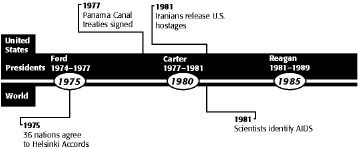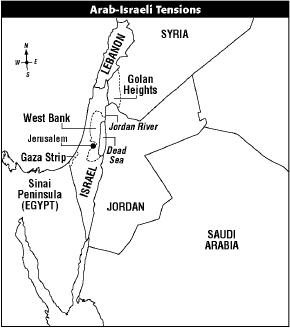Multiple Choice
Identify the
choice that best completes the statement or answers the question.
|
|
|
1.
|
President Carter turned control of the Panama Canal over to
a. | Egypt. | c. | Mexico. | b. | Syria. | d. | Panama. |
|
|
|
Gasoline Consumption and Prices | Year | Consumption | Cost per Gallon | | | (Billions of gallons) | Reg. | Prem. | No
lead | 1973 | 110.5 | $ .40 | .45 | NA | 1974 | 106.3 | .53 | .57 | .55 | 1975 | 109.0 | .57 | .61 | .60 | 1976 | 115.7 | .59 | .64 | .61 | 1977 | 119.6 | .62 | .67 | .66 | 1978 | 125.1 | .63 | .69 | .67 | 1979 | 122.1 | .86 | .92 | .90 | 1980 | 115.0 | 1.19 | 1.28 | 1.25 | | | | | |
|
|
|
2.
|
 Based on the chart above, how much would eight gallons of
unleaded gas have cost in 1975? a. | $4.80 | c. | $4.00 | b. | $4.60 | d. | $4.88 |
|
|
|
3.
|
 In what year shown on the chart above was United States
consumption of gasoline at its highest?
|
|
|
|
|
|
4.
|
 Based on the map, which of the following countries has
the most major oil fields? a. | Oman | c. | Iraq | b. | Kuwait | d. | Iran |
|
|
|
5.
|
 Based on the map, which of the following countries is
not on the Persian Gulf? a. | Lebanon | c. | Israel | b. | Syria | d. | all of the
above |
|
|
|
6.
|
 All of the major bodies of water on this map are
connected by oil pipelines except which one of the following? a. | Caspian Sea | c. | Persian Gulf | b. | Red Sea | d. | Mediterranean
Sea |
|
|
|
7.
|
 Which of the following is not noted as a
short-term effect of the energy crisis on the chart above? Effects of the Energy
Crisis | | Short-Term
Effects | Long-Term Effects | | increase in price of gasoline | creation of U.S. Department of Energy | | long lines at gas stations | research into alternative
energy sources | | gasoline rationing | changes in
automobile design and technology | | shortages of
gasoline | laws requiring increase in energy efficiency of housing | | feelings of frustration | public awareness of
conservation | | |
a. | increase in carpooling | c. | long lines at gas stations | b. | increase in price of
gasoline | d. | feelings of
frustration |
|
|
|
|
|
|
8.
|
 Based on the information, what percentage of the federal
expenditure goes toward paying interest on public debt? a. | 7 percent | c. | 10 percent | b. | 11 percent | d. | 12 percent |
|
|
|
9.
|
 Based on the two circle graphs, in 2001 almost half of
the federal income came from what single source? a. | individual income tax | c. | social security tax | b. | defense & social
security | d. | corporate income
tax |
|
|
|
10.
|
What scandal forced President Nixon to resign?
a. | Watergate | c. | Iran-Contra | b. | Agnew | d. | Middle East |
|
|
|
11.
|
American hostages were held captive by students from which country?
a. | Iraq | c. | Israel | b. | Iran | d. | India |
|
|
|
| Events of the 1970s | Results and
Reactions | | OPEC oil embargo causes a
shortage of fuel. | Americans feel helpless and angry. | | President Ford vetoes programs in health, housing, and education to reduce government
spending. | Many people lose jobs, and the nation suffers the worst recession in 40 years. | | Ford pardons Nixon. | Americans feel
frustrated. | | To conserve energy, Americans
buy smaller, imported cars. | American workers suffer unemployment as several automobile plants
close. | | Americans learn CIA and FBI
have secret files on citizens. | Americans become angry at government’s abuse of
power. | | |
|
|
|
12.
|
 Based on the information in the chart, which of the
choices below best describes the general mood shared by Americans in the 1970s? a. | optimistic | c. | disgruntled | b. | joyous | d. | silly |
|
|
|
13.
|
 According to the chart, about which issue did Americans
feel frustrated? a. | CIA and FBI having secret files on citizens | b. | OPEC oil embargo
causing an oil shortage | c. | buying smaller imported cars to conserve
energy | d. | Ford pardoning Nixon |
|
|
|
14.
|
What kept American athletes from attending the 1980 summer Olympic Games?
a. | American hostages in Iran | c. | Soviet invasion of
Afghanistan | b. | earthquake in Japan | d. | corruption in China |
|
|
|
15.
|
  Based on the time line, who defeated
Ford in the 1976 presidential election? a. | Clinton | c. | Reagan | b. | Nixon | d. | Carter |
|
|
|
|
|
|
16.
|
 Based on the map, about how long is the Alaska
Pipeline? a. | about 750 miles | c. | about 300 kilometers | b. | about 750 kilometers | d. | about 300 miles |
|
|
|
17.
|
 The capital of Alaska, Juneau, is on what body of
water? a. | Beaufort Sea | c. | Gulf of Alaska | b. | Chukchi Sea | d. | Bering Sea |
|
|
|
18.
|
When President Nixon resigned, he was succeeded by
a. | Gerald Ford. | c. | John Dean. | b. | Spiro Agnew. | d. | Jimmy Carter. |
|
|
|
19.
|
  Based on the map of Arab-Israeli
tensions, which of the following regions is in Syria? a. | Golan Heights | c. | West Bank | b. | Sinai Peninsula | d. | Gaza Strip |
|
|
|
20.
|
Which country did President Carter condemn for its policy of apartheid?
a. | Uruguay | c. | South Africa | b. | Argentina | d. | Ethiopia |
|
|
|
21.
|
Jimmy Carter seemed weak and uncertain because of his reversal on
a. | the trade deficit. | c. | human rights. | b. | economic policies. | d. | apartheid. |
|
|
|
22.
|
What caused President Gerald Ford a loss of popularity and trust with the
American people?
a. | low unemployment rate | c. | lack of inflation | b. | Nixon's pardon | d. | environmental
crisis |
|
|
|
23.
|
 According to the chart, how many barrels per day did the
United States import from Arab OPEC in 1977–1978? United States Net Imports of Petroleum, 1973-1983 | | | Average Annual Rate in Thousands of Barrels per
Day | Year | From Arab
OPEC* | From OPEC** | From All Countries | 1973 | 914 | 2,991 | 6,025 | 1974 | 752 | 3,277 | 5,892 | 1975 | 1,382 | 3,599 | 5,846 | 1976 | 2,423 | 5,063 | 7,090 | 1977 | 3,184 | 6,190 | 8,565 | 1978 | 2,962 | 5,747 | 8,002 | 1979 | 3,054 | 5,633 | 7,985 | 1980 | 2,549 | 4,293 | 6,365 | 1981 | 1,844 | 3,315 | 5,401 | 1982 | 852 | 2,136 | 4,298 | 1983 | 630 | 1,843 | 4,312 | *Arab OPEC members include Algeria, Iraq, Kuwait, Libya,
Qatar, Saudi Arabia, and United Arab Emirates.
**OPEC members
include Arab OPEC countries and Gabon, Indonesia, Iran, Nigeria, and Venezuela. | | | | |
a. | 3,184,000 | c. | 6,164,000 | b. | 61,640,000 | d. | 6,146,000 |
|
|
|
24.
|
Who was the first American president to visit behind the iron curtain?
a. | George H.W. Bush | c. | Richard M. Nixon | b. | John F. Kennedy | d. | Ronald Reagan |
|
|
|
25.
|
President Carter helped the peace process in the
a. | Soviet Union. | c. | European nations. | b. | Middle East. | d. | Latin American
countries. |
|